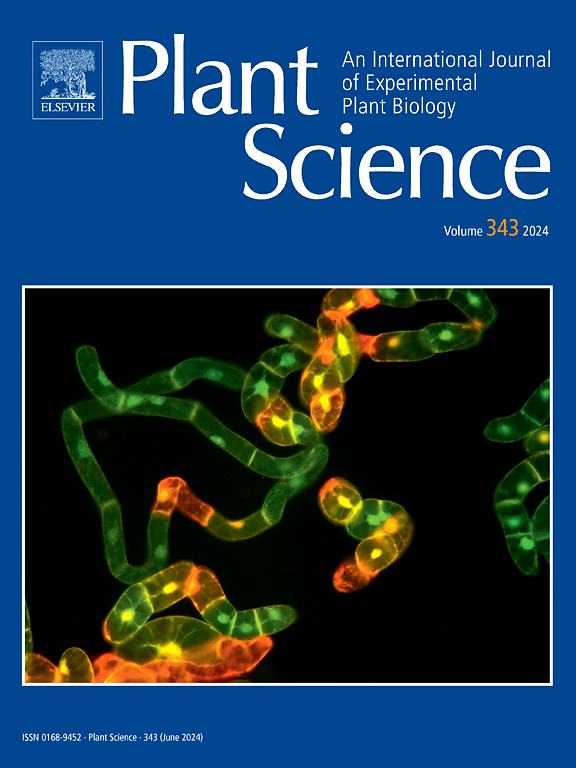IF 4.2
2区 生物学
Q2 BIOCHEMISTRY & MOLECULAR BIOLOGY
引用次数: 0
摘要
C2H2型锌指蛋白(ZFPs)在植物应对多种胁迫环境的基因转录调控中发挥着重要作用。本研究考察了大豆ZFP家族成员GmZAT10-1基因及其启动子对盐胁迫的响应,以及过表达(OE)或CRISPR/Cas9(KO)-GmZAT10-1毛根复合大豆幼苗和转基因拟南芥在盐胁迫下幼苗生长表型的变化和相关生理指标。结果表明,GmZAT10-1及其启动子对盐胁迫均有增强的诱导作用,GmZAT10-1蛋白具有转录激活活性并位于细胞核内。GmZAT10-1在烟草叶片中的瞬时表达和酵母单杂交试验(Y1H)表明,GmZAT10-1能与GmCLC-c1的启动子结合,从而增强靶基因的表达。与空载体转化(Ev)的毛根复合大豆植株相比,盐胁迫 OE-GmZAT10-1 和 KO-GmZAT10-1 植株的盐害程度减轻,植株高度、单株鲜重、叶片相对含水量(RWC)和叶绿素含量增加,根和叶的相对电解渗漏(REL)和丙二醛(MDA)含量降低、其中,OE-GmZAT10-1 根中 Cl- 和 NO3- 的积累明显增加,这明显减少了 Cl- 向茎和叶的运输和积累,从而导致根、茎和叶中 Cl-/NO3- 的比值明显下降。将GmZAT10-1基因导入到A. thaliana野生型(WT)和atzat10突变体中,WT-GmZAT10-1和atzat10-GmZAT10-1在盐胁迫下的种子萌发率和根长明显恢复,叶片叶绿素含量和RWC显著增加,而REL值和MDA含量显著降低。此外,根中的 Cl- 和 Na+ 有明显积累,这导致芽中的 Cl-/NO3 和 Na+/K+ 比值明显下降。综上所述,这些研究结果表明,转录因子 GmZAT10-1 可通过与 GmCLC-c1 基因启动子结合,上调该基因的表达,从而调节大豆根系对 Cl- 的吸收,并减少其向地上部分(包括植株的茎、叶)的转移,从而维持相对较低的 Cl-/NO3- 比率,从而赋予大豆耐盐性。本文章由计算机程序翻译,如有差异,请以英文原文为准。
Physiological functions of the transcription factor GmZAT10-1 gene involved in the salt stress adaptation in soybean
C2H2-type zinc finger proteins (ZFPs) play important roles in the gene transcriptional regulation in the response of plants to multiple stressful environments. In this work, the responses of the soybean ZFP family member GmZAT10–1 gene and its promoter to salt stress, and the changes in the seedling growth phenotype, as well as the related physiological parameters in overexpressing (OE)– or CRISPR/Cas9 (KO)–GmZAT10–1 hairy-root composite soybean seedlings and transgenic Arabidopsis thaliana under salt stress were investigated. The results showed that both GmZAT10–1 and its promoter exhibited enhanced induction to salt stress, and the GmZAT10–1 protein displayed the transcriptional activation activity and was located in the cell nucleus. Transient expression of GmZAT10–1 in tobacco leaves and yeast one-hybrid assay (Y1H) revealed that GmZAT10–1 can bind to the promoter of GmCLC-c1 to enhance the expression of the target genes. Compared with the empty vector–transformed (Ev) hairy-root composite soybean plants, the salt-stressed OE-GmZAT10–1 and KO-GmZAT10–1 plants presented mitigated salt injury, greater plant height, fresh weight per plant, leaf relative water content (RWC) and chlorophyll content, and lower relative electrolytic leakage (REL) and malondialdehyde (MDA) content in the roots and leaves, among which the accumulation of Cl– and NO3– increased significantly in the roots of OE-GmZAT10–1, which obviously reduced the transport and accumulation of Cl– to the stems and leaves, and thus resulting in a marked decrease in Cl–/NO3– ratio in the roots, stems and leaves. By introducing the GmZAT10–1 gene into A. thaliana wild-type (WT) and atzat10 mutant, the seed germination rates and root lengths of WT-GmZAT10–1 and atzat10-GmZAT10–1 under salt stress were obviously restored, and the leaf chlorophyll content and RWC were significantly increased, whereas the REL values and MDA contents were significantly decreased. Additionally, significant accumulation of Cl– and Na+ was observed in the roots, which resulted in a significant decrease in Cl–/NO3–and Na+/K+ ratios in the shoots. Taken together, these findings indicate that the transcription factor GmZAT10–1 may confer salt tolerance in soybeans by upregulating the expression of the GmCLC-c1 gene through binding to its promoter, regulating the uptake of Cl– by the roots and reducing its translocation to the above-ground parts, including the stems and leaves of the plants, thereby maintaining a relatively low Cl–/NO3– ratio.
求助全文
通过发布文献求助,成功后即可免费获取论文全文。
去求助
来源期刊

Plant Science
生物-生化与分子生物学
CiteScore
9.10
自引率
1.90%
发文量
322
审稿时长
33 days
期刊介绍:
Plant Science will publish in the minimum of time, research manuscripts as well as commissioned reviews and commentaries recommended by its referees in all areas of experimental plant biology with emphasis in the broad areas of genomics, proteomics, biochemistry (including enzymology), physiology, cell biology, development, genetics, functional plant breeding, systems biology and the interaction of plants with the environment.
Manuscripts for full consideration should be written concisely and essentially as a final report. The main criterion for publication is that the manuscript must contain original and significant insights that lead to a better understanding of fundamental plant biology. Papers centering on plant cell culture should be of interest to a wide audience and methods employed result in a substantial improvement over existing established techniques and approaches. Methods papers are welcome only when the technique(s) described is novel or provides a major advancement of established protocols.
 求助内容:
求助内容: 应助结果提醒方式:
应助结果提醒方式:


